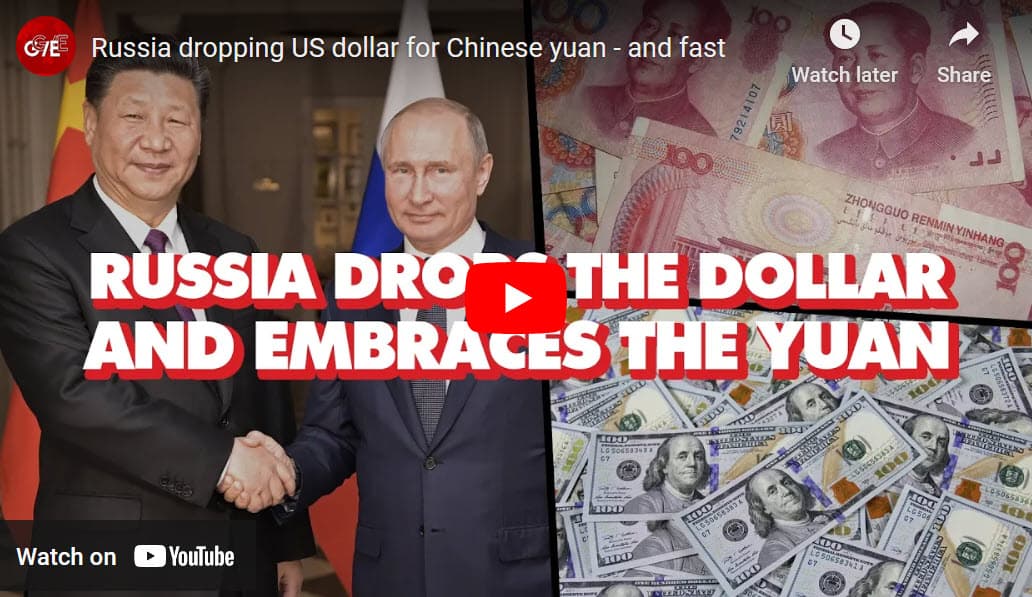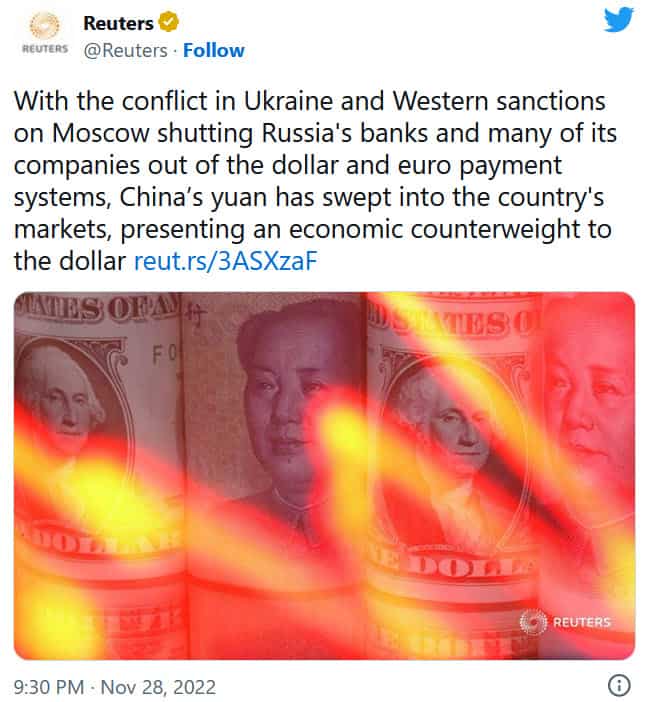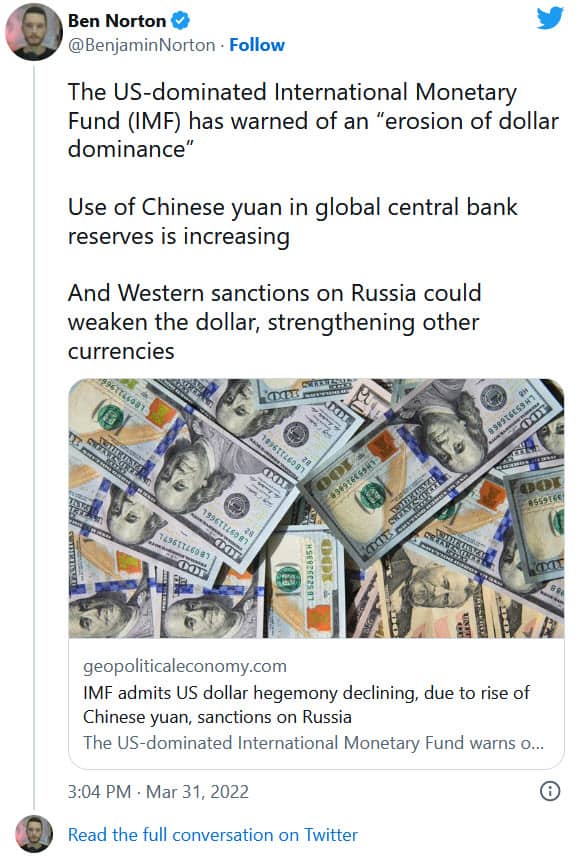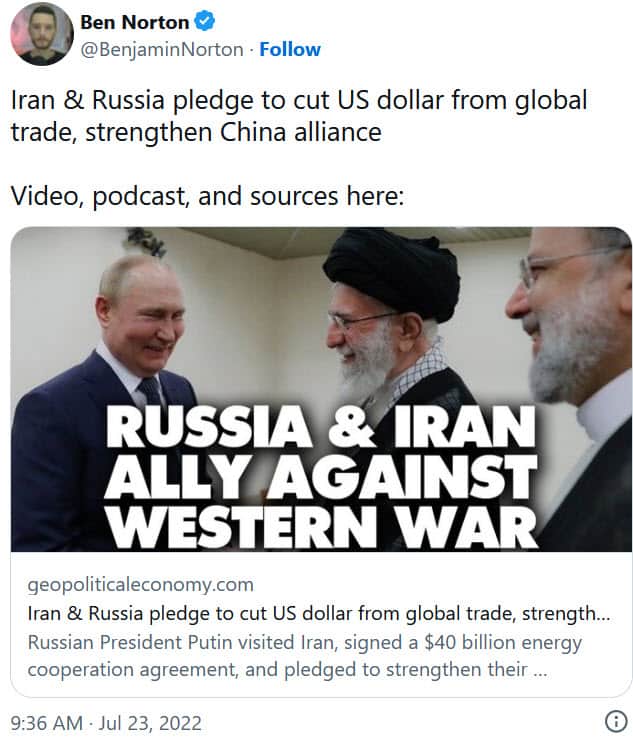Russia Dropping US Dollar for Chinese Yuan – And Fast
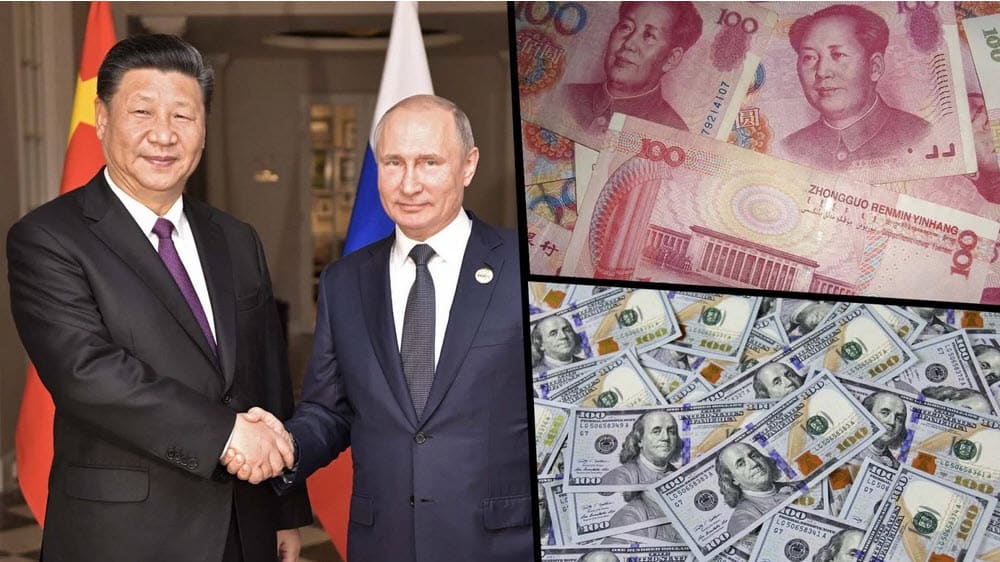
by Ben Norton, Global Research [1-13-2023 published].
In response to Western sanctions, Russia’s central bank is dropping the US dollar and will buy Chinese yuan on the foreign exchange market. The yuan’s share of Moscow’s currency trading increased from 1% to 40-45% in 2022, while dollar trade halved from 80% to 40%.
Russia has spent years trying to decrease its dependency on the US dollar. But especially since the escalation of the proxy war in Ukraine in 2022, Moscow has accelerated its drive toward de-dollarization.
Western sanctions have locked Russia out of the US-dominated international financial architecture. Numerous Russian banks were disconnected from the SWIFT inter-bank messaging system. Washington and Brussels even froze a staggering $300 billion of the Russian central bank’s foreign exchange reserves.
In response, Russia’s central bank has largely abandoned the US dollar and euro, and instead it plans to buy Chinese yuan on the currency market.
In the span of less than a year, the yuan has quickly replaced the dollar as the most sought foreign currency in Moscow.
According to the Federal Reserve, the US dollar is involved in around 80% of global trade, and the dollar makes up approximately 60% of globally disclosed official foreign reserves, as of 2021.
But rising geopolitical conflict, fueled by Washington’s new cold war, has pushed Russia, China, Iran, and a growing list of countries to try to de-dollarize, or at least to diversify their foreign reserves.
READ MORE: Who Holds Russia’s Central Bank Reserves?
Reuters reported that daily “yuan-rouble trading volumes on the Moscow Exchange are already exceeding dollar-rouble trades on some days,” and noted that this trend is likely to increase in 2023.
Russia has already made importers of its oil and gas pay in its currency, the ruble, in a challenge to the petrodollar.
An anonymous source in Russia’s banking system told Reuters, “The central bank can currently now buy yuan,” and, “if next year budget revenues from the export of oil and gas exceed 8 trillion roubles, then the central bank will buy yuan.”
Another anonymous source in the Russian government said to Reuters, “We have a lot of friendly currencies. On the exchange, the Chinese yuan is the most traded currency, it is the friendliest currency so far.”
[Click image to read Twitter thread]
reut.rs/3ASXzaF: The yuan's the new dollar as Russia rides to the redback
In a separate report, titled “The yuan’s the new dollar as Russia rides to the redback,” Reuters revealed that the yuan’s share of trading on Russia’s currency market increased from 1% to 40-45% in less than a year.
At the same time, dollar trade halved from 80% to 40% of volumes on the Moscow Exchange.
Russia has quickly become the world’s fourth-biggest offshore trading center for renminbi – a drastic change, considering it was not even in the top 15 at the beginning of the year.
Reuters acknowledged that Moscow’s de-dollarization campaign is not new, but it accelerated in 2022.
“While the yuan, or renminbi, has been making gradual inroads into Russia for years, the crawl has turned into a sprint in the past nine months as the currency has swept into the country’s markets and trade flows,” the media outlet wrote.
It added, “Russia’s financial shift eastwards could boost cross-border commerce, present a growing economic counterweight to the dollar and limit Western efforts to pressure Moscow by economic means.”
In a report in March, the International Monetary Fund (IMF) warned of an “erosion of dollar dominance.”
[Click image to read Twitter thread]
Read the full conversation on Twitter
The IMF noted that the use of Chinese yuan in global central bank reserves has increased, while holdings of the US dollar declined from roughly 70% in year 2000 to less than 60% by 2021.
Western sanctions on Russia have also incentivized countries around the world to create new financial systems for regional trade in other currencies – not just adversaries, but also longtime US allies such as India, Egypt, and even Saudi Arabia.
In July, Russia’s President Vladimir Putin visited Iran, where the two countries signed a $40 billion energy cooperation agreement, and pledged to deepen their economic integration.
Both Putin and Iran’s Supreme Leader Ali Khamenei called to challenge the dominance of the US dollar, instead proposing the use of local currencies for trade.
[Click image to read Twitter thread]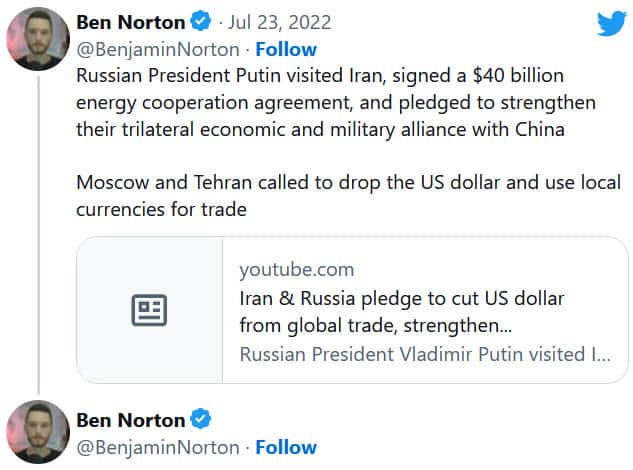
[Click image to read "Iran & Russia pledge to cut US dollar from global trade, strengthen China alliance"]
